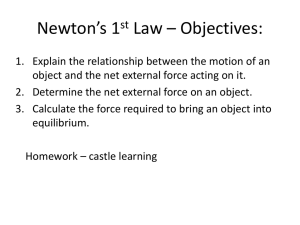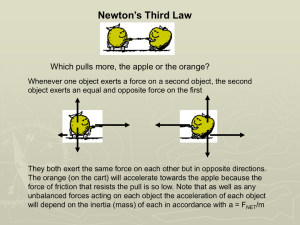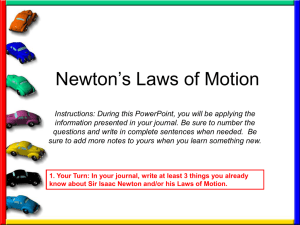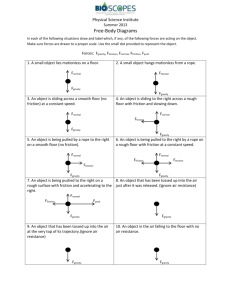Newton`s Laws
advertisement
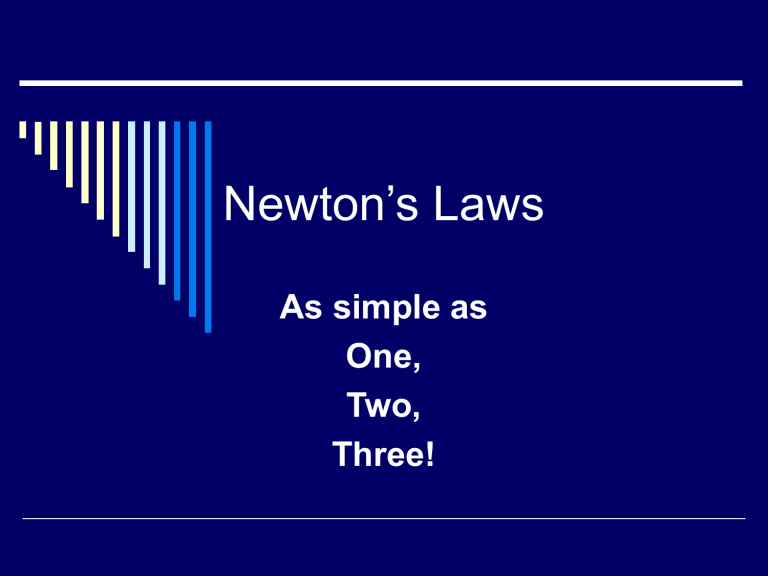
Newton’s Laws As simple as One, Two, Three! Inertia Newton’s First Law is often called the Law of Inertia. But what is inertia? Inertia is the natural tendency for an object to maintain a state of rest or to maintain a state of uniform motion in a straight line. In other words, any object likes to maintain its constant velocity. Mass and Inertia Mass and Inertia are very much linked together. In fact, Newton said that mass was a measurement of inertia. The more mass something has, the more inertia it has. If a 350 lb person and a 85 lb person are both walking towards you at a constant velocity. Which one would be easier to stop? The one with the smaller mass, thus smaller inertia. Newton’s First Law An object at rest will remain at rest, and an object in motion will continue in motion with constant velocity (that is constant speed in a straight line) unless acted upon by a net external force. What is true for both of these situations is that all forces equal zero. At rest, the net force is zero. Fnormal=Fweight Fnormal Fweight In constant velocity, the net force is also zero. Fnormal=Fweight Fresistance=Fforward Fnormal Fresistance Fweight Fforward Newton’s Second Law Newton’s Second Law is looked at as one of the most important laws in physics. This is because it is used throughout. You will use this law in equation-form more than any other Newton’s Second Law a Fnet 1 a m Fnet a or Fnet ma m Problem Solving Strategies When solving problems that involve Fnet=ma, it is important to separate the problem into the different coordinates (i.e. x,y, and z). Fx=max Fy=may Fz=maz Fnormal Fresistance Fweight Fx = Fforward – Fresistance = max Fy = Fnormal – Fweight = may Fforward Newton’s Second Law Problems A 88 kg crate is being pushed with horizontal force of 300 Newtons over a flat ice rink (there are no resistive forces). If started from rest, find the net force in both the x and y direction, the acceleration in the x direction, and the normal force on the crate. a) Fx = Fapplied (push) - 0 = max Fy = Fnormal - Fweight = may b) Fx = Fapplied (push) - 0 = max 300 N-0 N = (88 kg) (ax) ax = 300 N / 88 kg = 3.41 m/s2 c) Fy = Fnormal - Fweight = may Fnormal = Fweight – may Fnormal = (88 kg) (9.8 m/s2) - (88 kg) (0 m/s2) Fnormal = 862.4 N (Notice the normal is the same as the weight. That will always be true as long as the object is on a horizontal surface and it is at a constant velocity – in this case zero.) Newton’s Third Law Newton’s Third Law is probably the most misunderstood of the three laws. It states: For every action, there is an equal but opposite reaction. This is not as simple as it sounds! An example of this is a big moving truck and a little Volkswagen Carmengia hitting each other in a headon collision. It is our nature to say that the moving truck hits the Carmengia with a greater force than the Carmengia hits the moving truck with. Why is that? Well, this assumption is not true. They hit each other with the same force, just in opposite directions. WATCH OUT!!! Why is this true? The forces may be the same, but the masses are very different. Since Fnet=ma, the acceleration must go up for the Carmengia because the mass is so small. Likewise, the truck has a very small acceleration because it has such a large mass. Ftruck on car=Fcar on truck Fcar on truck=ma (of truck) Ftruck on car =ma (of car) Newton’s Third Law Problems A 2000 kg truck rear-ends a 400 kg car (both traveling to the right). If the impact force was 5000 Newtons, what are the accelerations of the truck and car respectfully? The force on the truck is going to be negative (to the left), while the force on the car will be positive (to the right). atruck=Fcar on truck/mtruck atruck= -5000 N/2000 kg atruck= -2.5 m/s2 (it slows down) acar=Ftruck on car/mcar acar= 5000 N/400 kg acar=12.5 m/s2 (it speeds up)




